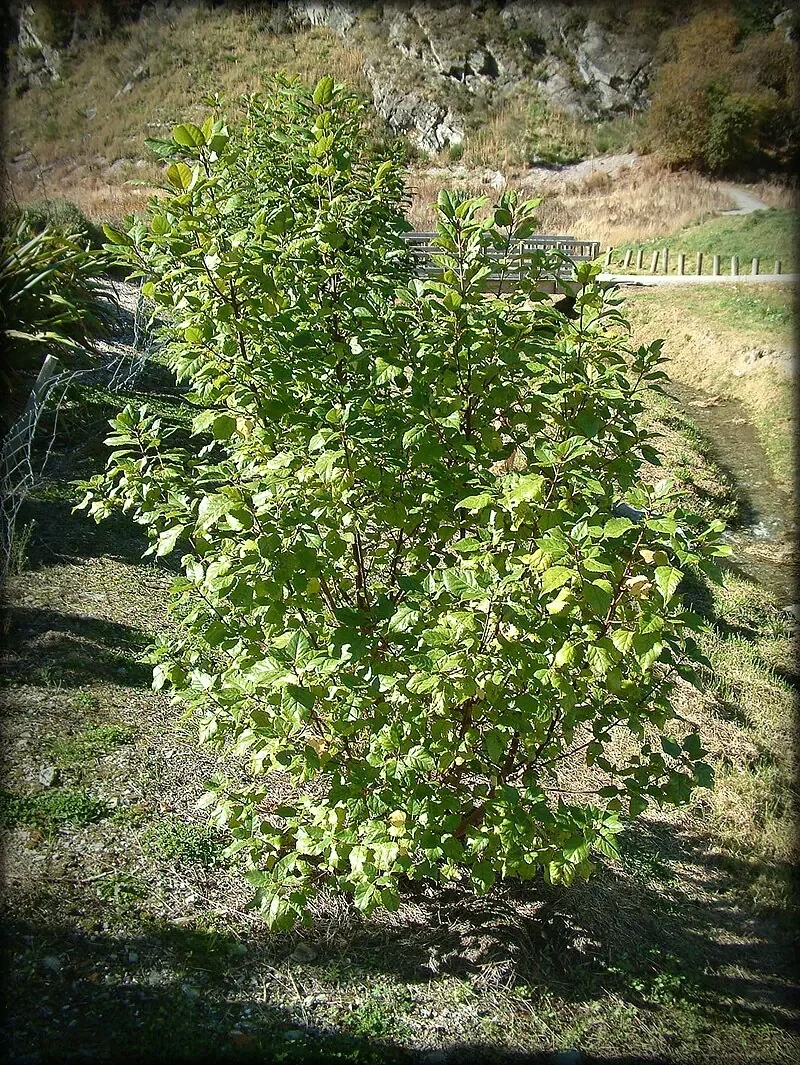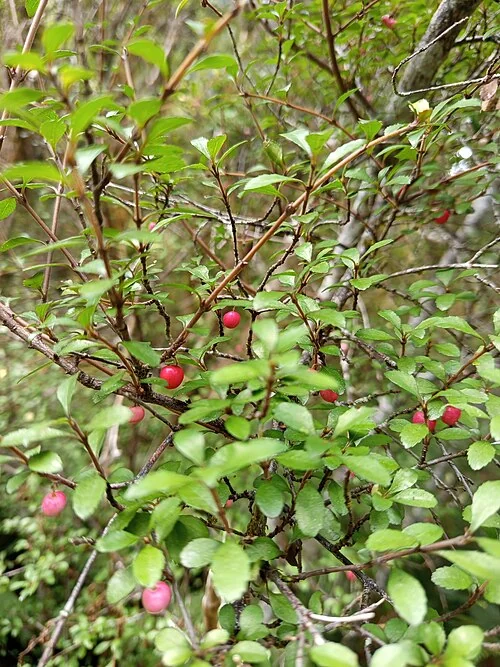
Wineberry
Aristotelia serrata
Introduction
Essential Information
Wineberry ( Aristotelia ), also known as makomako, is a fast-growing New Zealand native tree with attractive pinkish-red berries and serrated leaves. It is valued for its ecological role and ornamental appeal. native shrubs .

Plant Description
Botanical Features
Wineberry ( Aristotelia serrata ) is a distinctive native plant with unique botanical characteristics that make it well-suited to New Zealand's diverse environments. This species exhibits typical features of its genus and family, with specialized adaptations that allow it to thrive in its natural habitat. The plant 's morphological features, including its leaf structure, growth habit, and reproductive characteristics, reflect millions of years of evolution in New Zealand's isolated environment. Understanding the botanical description of Wineberry helps gardeners appreciate its unique characteristics and provides insight into its cultivation requirements and ecological role.
Quick Facts
Key Features
| Scientific Name | Aristotelia Serrata |
|---|---|
| Height | Up to 10 m (usually 4-8 m in gardens) |
| Spread | 3-5 m (bushy, upright habit) |
| Water Needs | Moderate; prefers moist, fertile soil |
| Light | Full sun to partial shade |
| Frost Tolerance | Moderate (tolerates light to moderate frost) |
| Salt Tolerance | Low to moderate (not suited to exposed coastal sites) |
| Growth Rate | Fast (especially in open, sunny sites) |
| Lifespan | Short to moderate (10-30 years) |
Climate Best Suited to
Preferred Conditions
| City | Suitability |
|---|---|
| Whangārei | Ideal |
| Auckland | Ideal |
| Hamilton | Ideal |
| Tauranga | Ideal |
| Rotorua | Ideal |
| Gisborne | Ideal |
| New Plymouth | Ideal |
| Napier | Ideal |
| Whanganui | Ideal |
| Palmerston North | Ideal |
| Wellington | Ideal |
| Nelson | Ideal |
| Christchurch | Ideal |
| Dunedin | Ideal |
| Invercargill | Ideal |
Wineberry is best suited to mild, temperate climates throughout New Zealand, but may be less vigorous in the far south.
Natural Habitat
Typical Environments
Aristotelia is naturally found in specific habitats throughout New Zealand. Understanding its natural environment helps in providing appropriate growing conditions in cultivation.
Plant Conservation
Threats and Efforts
Wineberry ( Aristotelia serrata ) is currently classified as "Not Threatened" nationally in New Zealand, indicating a relatively secure conservation status. Its widespread distribution across various habitats, including disturbed areas, contributes to its resilience. However, like many native species, it can face localized threats.
While not a primary focus of intensive conservation efforts, the protection of Wineberry is inherently linked to broader native forest and ecosystem conservation initiatives. Its ecological role as a food source for native birds, particularly the kererū, means that efforts to protect these birds also indirectly benefit Wineberry populations through seed dispersal. Management of introduced pests that browse on native vegetation can also help maintain healthy Wineberry stands. Continued habitat preservation and restoration, especially in areas where it provides crucial resources for native fauna, are important for ensuring the ongoing health and abundance of this culturally and ecologically significant plant.
Soil Requirements
Prefers moist , fertile soils and benefits from mulching.
Light Requirements
Grows quickly in disturbed or open areas.
Water Requirements
Prune to maintain shape and encourage bushiness.
Planting Guide
Site Preparation
- Choose a sunny or partially shaded site with moist soil.
- Dig a hole twice as wide as the root ball.
- Mix compost into the soil for fertility.
- Plant at the same depth as in the pot and backfill.
- Water well and mulch around the base.
Ecological Role
Wildlife Interactions
Aristotelia plays an important ecological role in New Zealand's native ecosystems. It provides habitat and food for native wildlife and contributes to ecosystem health and biodiversity.
Uses and Significance
Garden Uses
- Revegetation, shelter, edible berries
This native plant serves multiple purposes in gardens and landscapes. It provides habitat for wildlife, stabilizes soil, and adds aesthetic value.
Landscaping Uses
Practical Applications
Aristotelia is highly valued in landscaping for its aesthetic appeal and practical benefits. It can be used in various garden styles and landscape applications.
Seasonal Care
Spring
- Prune to shape and remove dead wood.
Summer
- Water during dry spells and harvest berries.
Autumn
- Collect seeds for propagation.
Winter
- Mulch and protect young plants from frost.
Pruning
Fast Grower
Wineberry is fast-growing and can become straggly. Prune after fruiting (late summer/autumn) to maintain a bushy shape and control size. It regenerates strongly from hard pruning if needed.
How to Grow Wineberry
Seeds
Seed propagation is the most straightforward and reliable method for growing Wineberry, with excellent germination rates when fresh seeds are used and proper techniques are followed. Seeds mature between January and April, with optimal collection timing in February when berries have turned from pink to dark red or purple-black, indicating full maturity. Collect ripe berries and process them immediately by softening the fruit, mashing thoroughly, and washing to remove all pulp through repeated decanting until only clean seeds remain. Any remaining fruit material can inhibit germination and promote fungal growth, so thorough cleaning is essential. Fresh seeds should be sown immediately upon preparation, as they lose viability rapidly if stored. Use a quality seed-raising mix in shallow trays or individual pots, ensuring the growing medium provides good drainage while retaining adequate moisture. Sow seeds on a firm bed of seed-raising mix and cover lightly with a thin layer of fine sand or vermiculite, no more than 2-3mm deep. Maintain consistently moist conditions at temperatures between 15-20°C for optimal germination. Initial germination typically begins after 17 days, with most seeds germinating within 70 days, though some may take up to 2 months. If sown in autumn, any ungerminated seeds will often emerge the following spring between September and October. Seedlings develop rapidly under suitable conditions and can be transplanted to individual containers within 2-3 months when they have developed several true leaves and a strong root system. This method produces vigorous plants that establish quickly and grow rapidly once planted out.
Cuttings
Cutting propagation of Wineberry is remarkably successful and provides a reliable method for producing plants identical to the parent, making it valuable for maintaining specific characteristics or gender when fruit production is desired. Semi-hardwood cuttings taken during summer offer the best success rates, when new growth has begun to firm up but remains flexible. Select healthy, non-flowering shoots from the current season's growth, choosing material 15-30cm in length that shows vigorous growth and no signs of pest damage or disease. Take cuttings in early morning when plants are fully hydrated, making clean cuts with sharp, sterile secateurs just below a node. Remove lower leaves while retaining 3-4 pairs at the tip to reduce water loss while maintaining photosynthetic capability. Cuttings can be inserted directly into well-draining propagation mix in pots or even planted directly in open soil within a protected greenhouse environment. For container propagation, use a mixture of equal parts peat moss and perlite or quality propagation mix that provides excellent drainage. Insert cuttings to approximately half their length, ensuring at least two nodes are buried beneath the surface. Maintain consistent moisture without waterlogging and provide bright, indirect light with protection from extreme temperatures. Root development is typically very rapid, with most cuttings developing sufficient root systems within 4-6 weeks during active growing seasons. Once well-rooted, cuttings can be potted up individually in early summer and grown on until ready for planting out. This method's ease and reliability make it particularly valuable for restoration projects where large numbers of plants are needed quickly.
Natural Regeneration
Wineberry demonstrates exceptional natural regeneration capabilities, making it an outstanding colonizing species for revegetation projects and naturalistic gardens where minimal intervention is desired. The plant's rapid growth, prolific fruiting, and excellent seed dispersal by native birds create ideal conditions for natural establishment and spread. Mature trees produce abundant crops of berries that are highly attractive to native birds including tūī, bellbirds, and silvereyes, which consume the fruit and disperse seeds throughout the surrounding area. Seeds pass through birds' digestive systems unharmed and are deposited in ideal growing locations with a natural fertilizer coating. Self-sown seedlings often appear in great numbers beneath and around parent plants during spring, establishing readily in disturbed soil, forest margins, and open areas. To encourage natural regeneration, simply allow berries to ripen fully and remain on the tree for bird consumption rather than collecting all fruit for propagation. Maintain areas of loose, disturbed soil around parent plants where seeds can readily germinate, and avoid heavy mulching that might prevent seed-to-soil contact. Young seedlings can be carefully transplanted during winter dormancy to desired locations, or simply left to establish naturally where space permits. This approach is particularly valuable for large-scale restoration projects where Wineberry serves as a fast-growing nurse species that improves soil conditions and provides shelter for other slower-establishing native plants. The species' ability to colonize quickly and improve degraded sites makes it an essential component of ecological restoration programs throughout New Zealand.
Pests and Diseases
Common Pests
Aristotelia is generally resistant to most pests due to its native adaptations. However, it may occasionally be affected by common garden pests such as aphids or scale insects.
Disease Prevention
To prevent diseases, ensure good air circulation around Aristotelia and avoid overwatering. Remove any diseased plant material promptly to prevent spread.
Cultural Significance
Traditional Uses and Values
Wineberry ( Aristotelia serrata ), or makomako, is a plant of great cultural significance to Māori. The berries were a food source, and the bark was used in traditional medicine (rongoā) for treating burns and skin ailments. The wood was also used for carving and construction.
Bonus Tip
Encouraging Native Birdlife
To truly enhance your garden's biodiversity and enjoy the vibrant presence of native New Zealand birds, consider planting Aristotelia serrata (makomako) alongside other berry-producing native plants. Makomako's abundant berries are a favorite food source for kererū, tūī, and bellbirds, especially during late summer and autumn.
By creating a diverse planting of native trees and shrubs that offer a succession of fruits throughout the year, you can provide a continuous food supply, encouraging these beautiful birds to frequent your garden. Additionally, ensure there are sources of fresh water and safe nesting sites nearby to create a complete habitat for local birdlife.







